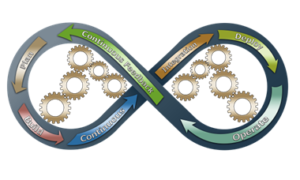
The Evolution of Agile Integration: Transforming the Integration Landscape
- Posted by Ahmed Wael
- On December 28, 2023
Agile integration has emerged as a transformative approach to integration in the modern software development landscape. It is a methodology that combines the principles of agile development with the need for flexible and adaptable integration solutions. In this blog, we will explore the evolution of agile integration, its benefits, and the key pillars that support its implementation.

Traditional Integration vs Agile Integration
In the past, traditional integration relied on a centralized Enterprise Service Bus (ESB) to connect applications and facilitate data exchange. This approach worked well for monolithic architectures but posed challenges when it came to scalability and adaptability. Agile integration, on the other hand, takes a more fine-grained approach, breaking down integrations into smaller, independent components. This allows for greater flexibility and agility in deploying and managing integrations.
The Benefits of Agile Integration
Agile integration offers several benefits that make it a preferred approach for modern software development organizations. Some of these benefits include:
- Faster Time to Market: Agile integration enables organizations to deliver new services and products to market more quickly. By breaking down integrations into smaller components, development teams can work on specific functionalities independently, reducing the time required for development and testing.
- Lower Risks: Agile integration takes an iterative approach to development, allowing for continuous testing and improvement. This reduces the risk of compatibility issues and ensures that the integration solution meets the organization’s requirements.
- Flexibility to Adapt: With agile integration, organizations have the flexibility to adapt to changing business needs and evolving technologies. The modular nature of agile integration allows for easy addition, removal, or update of integration components without disrupting the entire system.
- Improved Scalability: Agile integration supports the scaling of services based on demand. By deploying integrations in a distributed manner, organizations can scale individual components as needed, ensuring optimal resource utilization.
The Three Pillars of Agile Integration
Agile integration relies on three key pillars that form the foundation of its implementation. These pillars are:
- Distributed Integration: Distributed integration is a lightweight and API-based approach to integration. It allows for the deployment of integration components where they are needed and scales them as required. This flexibility enables organizations to include integration functionality directly within applications or as part of microservices architectures. Tools like Red Hat Fuse provide distributed integration capabilities through a variety of connectors for different services and messaging.
- Containers: Containers play a crucial role in agile integration by providing a platform for developing, deploying, managing, and scaling applications. Containers offer repeatability and can be managed programmatically, making them ideal for continuous development and deployment. Red Hat OpenShift Container Platform is a popular container platform that handles orchestration and management functions, allowing for seamless integration of containerized applications.
- APIs: APIs (Application Programming Interfaces) serve as interfaces that allow users, both internal and external, to connect with an organization’s business assets. APIs simplify the complexity of integration and promote collaboration. Managing, securing, and analyzing API usage is critical for providing competitive digital services. Red Hat 3scale API Management is a comprehensive solution for creating, connecting, and managing APIs.
Breaking Up the Enterprise Service Bus (ESB)
A significant aspect of adopting agile integration is the move away from a centralized ESB towards a more fine-grained, cloud-native deployment. The traditional ESB pattern, which involved a centralized hub for integrations, is replaced with a more modular and flexible approach. Instead of deploying all integrations in a single ESB, organizations can now deploy integrations in smaller groups or even individually. This allows for more efficient management and scalability of integrations.

Fine-Grained Deployment and Image-Based Deployment
Agile integration emphasizes fine-grained deployment, where integrations are deployed in small, independent components. This approach enables organizations to deploy integrations based on their specific needs and requirements. Image-based deployment further enhances the agility and consistency of integration solutions. Each integration is packaged as a container image, containing the necessary runtime and configuration. This approach ensures consistency in deployment across different environments and allows for easy replication and diagnostics.
Tailoring Integration Requirements
One of the advantages of agile integration is the ability to tailor integration requirements to specific needs. Each integration may have different non-functional requirements, such as availability and performance. With fine-grained deployment, organizations can configure each integration based on its unique requirements. This results in better runtime isolation, optimized resource usage, and greater deployment confidence. By grouping integrations with similar requirements, the number of predefined deployment configurations can be reduced, simplifying management and maintenance.
The Role of Serverless Frameworks
Serverless frameworks, such as Knative and KEDA, offer additional flexibility in agile integration. These frameworks allow for the allocation of compute resources only when there is workload demand. Integrations that have sporadic workloads can benefit from the serverless model, where containers are started only when messages or requests are received. This approach optimizes resource usage and reduces infrastructure costs.
Redefining Environments
Agile integration challenges the traditional approach of having multiple predefined environments for integration deployment. Instead of creating numerous environments in advance, organizations can adopt a more dynamic approach. With agile integration, the need for multiple environments is minimized, as integrations can be deployed independently and in isolation. This reduces infrastructure costs and simplifies the management of deployment configurations.
Conclusion
Agile integration has revolutionized the integration landscape, offering organizations a more flexible, scalable, and efficient approach to integration. By leveraging the principles of agile development and the three pillars of distributed integration, containers, and APIs, organizations can achieve faster time to market, lower risks, and improved adaptability. Breaking away from the traditional ESB pattern and embracing fine-grained deployment and image-based deployment further enhances the agility and consistency of integration solutions. With serverless frameworks and a redefined approach to environments, organizations can optimize resource usage and streamline integration processes. Agile integration is the key to unlocking the full potential of modern software development and integration.




